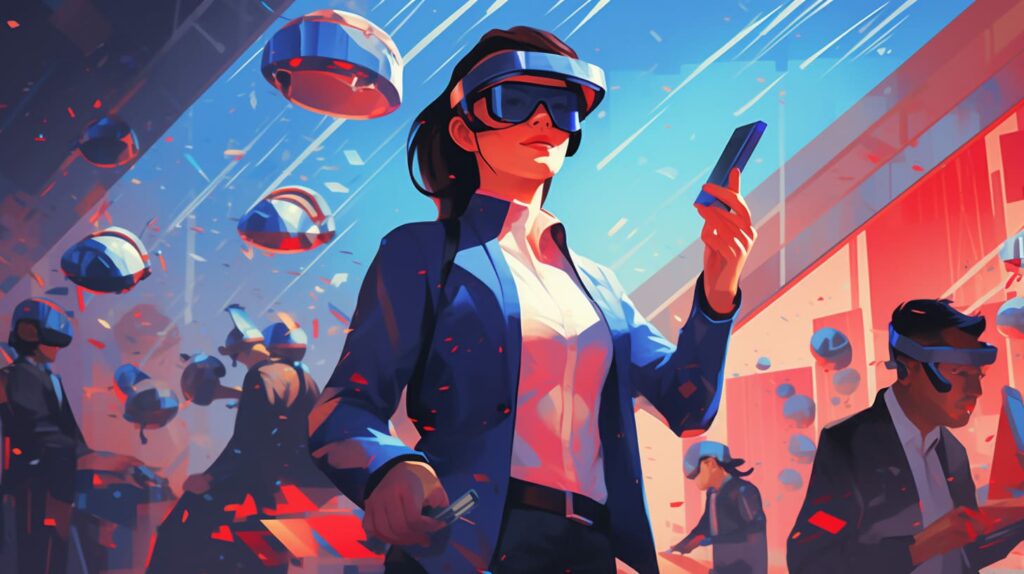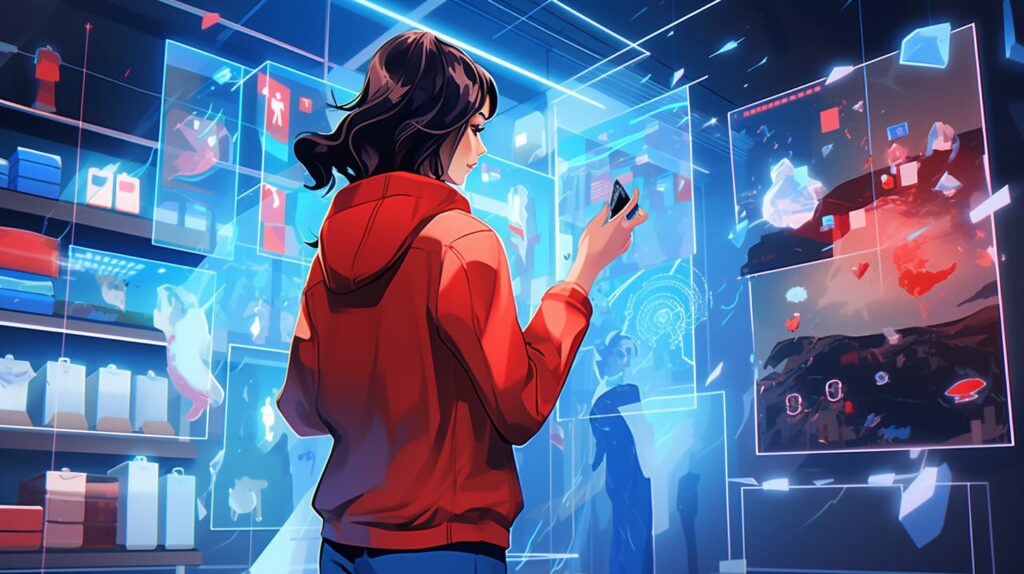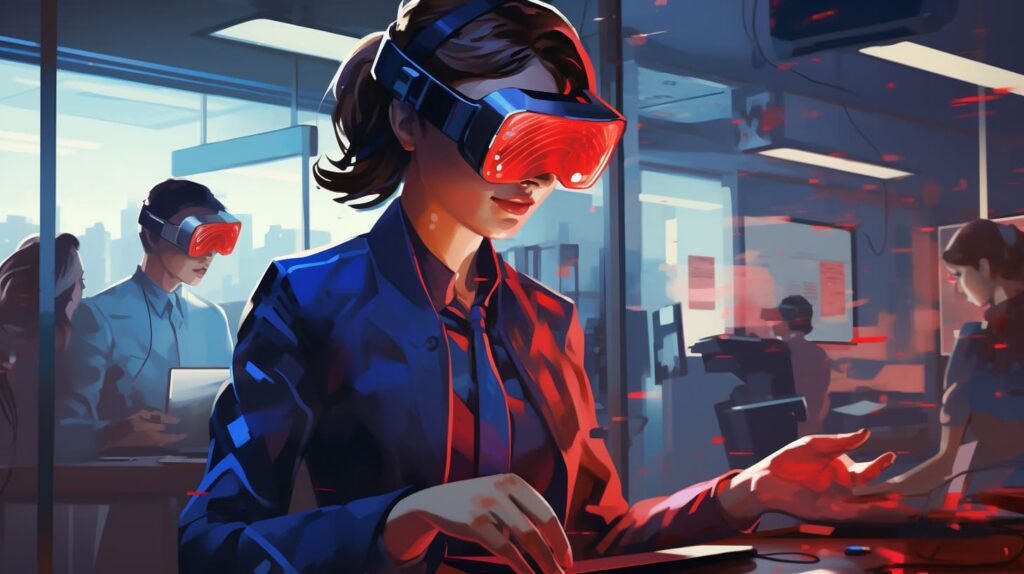In an age where technology is pushing boundaries, Augmented Reality (AR) and Virtual Reality (VR) stand as two remarkable innovations poised to revolutionize our world. No longer confined to the realms of science fiction, these technologies offer a glimpse into a future where the lines between the digital and the physical blur, enriching our lives in ways we are only beginning to understand. From the gaming industry to healthcare, from education to real estate, AR and VR technologies are making significant inroads, creating new experiences and, importantly, reshaping the future of work.
This article aims to delve deep into this fascinating universe of virtual worlds and augmented experiences. We will explore the impact of AR and VR on various industries, focusing on the job roles that are emerging and those that are being redefined. Whether you’re a job-seeker eyeing the next big thing, an employer looking for pioneering talent, or a tech enthusiast, understanding the far-reaching implications of these technologies is crucial.
As we journey through diverse sectors—each experiencing its own form of a digital metamorphosis—you’ll gain insights into the employment landscape that is quietly but surely changing beneath our feet. By the end of this read, you will be acquainted with the wondrous capabilities of AR and VR and have a clearer vision of the new roles and career paths that are paving the way for the next generation of workers in an increasingly digital world.
The Basics: What are AR and VR?
Augmented Reality (AR) and Virtual Reality (VR) are often mentioned simultaneously. But they are different. AR enhances the real world with digital elements. Think of Snapchat filters or Pokémon Go. VR, on the other hand, immerses you in a fully digital world. Think of Oculus Rift or VR video games.

Augmented Reality (AR)
In AR, users interact with both real and virtual objects. Your natural environment gets an overlay of digital information. This can be text, images, or interactive data. Smartphones and tablets are common devices for AR. More advanced options include smart glasses like Google Glass.
How It Started
AR has roots in the 1960s. The first AR system was Morton Heilig’s Sensorama. It combined multiple senses like sight, sound, and even smell. Modern AR is mostly visual and far more interactive.
Virtual Reality (VR)
VR places you in a different world altogether. Users wear a VR headset to dive into a 3D computer-generated environment. Here, you can interact with the setting and perform actions. It’s like stepping into a video game or a virtual world.
The Journey of VR
VR traces its origins back to the same era as AR. The first VR headset was the Morton Heilig’s Telesphere Mask, created in 1960. The technology has come a long way. Today’s VR is highly interactive and immersive.
The Difference
Remember, AR adds to reality. VR creates a new reality. AR lets you control virtual elements in the real world. In VR, you are part of the virtual world itself.
AR and VR in Gaming
No industry has adopted AR and VR like gaming. Both technologies offer heightened experiences. They have transformed traditional gaming into something far more interactive.

AR Gaming
Games like Pokémon Go have made AR mainstream. Users walk around in the real world and catch virtual Pokémon appearing on their screens. This mix of real and virtual makes AR gaming thrilling.
Job Opportunities
The AR gaming boom has opened up various roles. Game designers, AR developers, and UI/UX experts are in high demand. This niche will likely continue to grow.
VR Gaming
VR offers a deeper level of immersion. Games like Beat Saber and Half-Life: Alyx have set high standards. These games make you forget the boundary between the real and virtual world.
Career Paths in VR Gaming
VR gaming needs experts in 3D design and simulation. Sound engineers, game developers, and hardware experts are essential. As VR technology evolves, these roles will only become more specialized.
Convergence of AR and VR in Gaming
Some companies are blending AR and VR. This creates hybrid experiences. Gamers can transition between the real and virtual world. This trend could redefine gaming altogether.
The gaming industry is a gateway to understand the potential of AR and VR. These technologies are not just creating new types of games. They are also creating new job roles, redefining gaming, and setting the stage for other industries to follow.
AR and VR in Healthcare
Augmented Reality and Virtual Reality are transforming healthcare. They’re not just about entertainment. AR and VR technologies offer practical applications that can save lives and improve patient care.

Remote Surgeries
Imagine a surgeon performing a complex operation remotely. This is no longer science fiction. With VR headsets and precision controls, remote surgeries are becoming a reality.
Medical Training
Traditional medical training relies on cadavers and real-life patient encounters. VR changes that. Medical students can now practice on virtual patients. This allows for a risk-free learning environment.
Pain Management
Pain management is another area where VR shows promise. Experiments indicate that VR experiences can reduce perception of pain during procedures. This could limit the need for pain medication.
Diagnostics
AR can assist doctors in diagnostics. For example, overlaying digital images on physical bodies provides new perspectives. This can be particularly helpful in complex cases.
Psychological Treatment
Therapists are using VR for exposure therapy. This involves safely exposing patients to phobias or traumatic memories in a controlled environment.
Emerging Roles
So, what does this mean for jobs? There’s a growing demand for AR and VR specialists in healthcare. Other roles like medical illustrators and bioinformatics scientists are also seeing the impact of these technologies.
AR and VR in Education
Educational systems worldwide are exploring AR and VR. These technologies offer interactive and engaging learning experiences. The impact goes beyond traditional teaching methods.

Virtual Classrooms
COVID-19 accelerated the adoption of virtual classrooms. VR takes it a step further. Students can immerse themselves in a classroom setting from anywhere. They can interact with instructors and classmates as if they were physically present.
Interactive Learning
Standard textbooks may soon become obsolete. Imagine learning history by walking through a virtual ancient city. Or understanding biology by stepping inside a human cell. AR and VR can make this possible.
Special Needs Education
Students with special needs often require tailored educational approaches. VR can offer customized experiences that cater to individual learning styles and challenges.
Geography and Culture
Traveling the world is not feasible for every student. But VR can bring the world to the classroom. Students can take virtual field trips to learn about different cultures, ecosystems, and landmarks.
Skill-Based Training
Practical skills like woodworking or cooking can be taught using AR guides. This provides a hands-on learning experience without the associated risks.
Future Jobs in Education
AR and VR are creating new roles in education. Instructional designers, e-learning specialists, and edtech developers are in high demand. Teachers also need to adapt and acquire new skills to integrate these technologies into their methods.
Both healthcare and education are vital sectors experiencing the transformative power of AR and VR. These technologies offer new ways to solve old problems, creating job roles we couldn’t have imagined a few years ago.
AR and VR in Real Estate
In real estate, AR and VR technologies are more than just buzzwords. They are game changers. Virtual home tours have made it possible to explore properties without physically being there. Real estate agents are now able to showcase properties to potential buyers situated anywhere in the world. All a client needs is a VR headset or even a smartphone to walk through a property.
Virtual Home Tours
Virtual home tours are becoming the norm. In 2020, the COVID-19 pandemic made them almost a necessity. Even without a global pandemic, the benefits are clear. Buyers save time. Sellers get increased exposure. Real estate agents can focus on serious buyers. The technology is also continuously improving, offering 3D experiences that are ever closer to the real thing.
AR-Based Design
Augmented Reality is taking interior design to the next level. With AR apps, you can visualize different pieces of furniture in your space before buying them. Companies like IKEA already offer this kind of experience. This opens up a whole new avenue for interior designers and app developers to offer novel solutions for home customization.
New Career Opportunities
What does this mean for jobs? For one, real estate agents need to be tech-savvy. They need to understand how to operate the software that creates and shows virtual home tours. Photographers with skills in 360-degree photography have a new market to explore. Software developers specializing in AR and VR have new industries opening up to them. Interior designers can also extend their services to the virtual space, working on virtual staging and home customization.
Skill Requirements
If you’re looking to work in real estate and AR/VR, you’ll need a unique skill set. A background in real estate will help, but you also need to understand the technology. Skills in 3D modeling, UX/UI design, and even some coding could set you apart.
AR and VR in Retail
Virtual reality and augmented reality have also invaded the retail sector. These technologies create an immersive shopping experience. Imagine trying on clothes or testing products virtually before purchasing them. The application of AR/VR in retail extends from fashion to groceries and beyond.

Virtual Try-Ons
Fashion retail is one of the sectors most impacted by AR/VR. Brands are offering “virtual dressing rooms” that allow users to try on clothes without stepping into a store. This is a win-win for both the retailer and the customer. It saves time and reduces the number of returned items.
Immersive Shopping Experience
Grocery shopping is also evolving. Some stores offer VR experiences where you can walk through aisles, pick products, and check out, all while sitting at home. This level of immersion could become the standard for online shopping in the future.
Job Roles Impacted
The implications for employment are significant. Traditional roles in retail are evolving to include technological expertise. Customer service agents may need to become proficient in AR/VR technologies. Software developers are needed to create these new experiences, and data analysts are required to interpret user behavior in these virtual spaces.
New Roles Created
Beyond the evolution of existing roles, new jobs are being created. For example, AR/VR experience designers are now crucial for developing immersive retail environments. These individuals combine the skills of traditional design with tech-savvy insights to create virtual spaces.
Essential Skills
Soft skills like customer service and salesmanship are still important. However, additional technical skills are increasingly becoming necessary. Familiarity with AR/VR hardware and software and a basic understanding of data analytics could benefit anyone considering a career in this evolving sector.
Both the real estate and retail sectors demonstrate AR and VR technologies’ disruptive yet beneficial impact, not just in how we buy and sell, but also in how we work. By embracing these technologies, we’re not just part of the future—we’re creating it.
The Challenges of AR and VR
AR and VR have vast potential. But they come with challenges too. These challenges influence the job roles in these fields.
Technological Limitations
- Hardware Cost: High-quality AR and VR setups are expensive.
- User Experience: Lag or glitches can break immersion and cause discomfort.
- Battery Life: Mobile AR apps drain batteries fast.
Job implications? Developers are in high demand to solve these issues. Hardware engineers are needed for wearable technology. UX designers are crucial for smoother experiences.
Ethical Considerations
- Data Privacy: Collecting and storing user data poses privacy risks.
- Content Regulation: Preventing misuse of technology for illegal activities.
- Health: Extended VR use can cause physical strain.
Again, job roles shift. Data privacy officers become essential. Content moderators and healthcare experts are needed to monitor and set usage guidelines.
Accessibility
- Usability: AR and VR should be usable by people with disabilities.
- Global Reach: Limited Internet speeds can hamper AR and VR experiences in some regions.
Accessibility experts are needed to make AR and VR universal. This opens up roles for network optimization specialists.
The Future of AR and VR
We’ve seen the impact and challenges of AR and VR. Now, let’s look at the future. The future holds key trends that will shape job roles.
Software Development Kits (SDKs)
Future AR and VR will likely use more universal SDKs. This makes it easier to design cross-platform experiences—job implication: a rise in demand for SDK specialists.
5G Connectivity
5G will boost AR and VR capabilities. High-speed data transfer is crucial for these technologies. Network engineers and telecom specialists will see increased demand.
Artificial Intelligence (AI)
AI combined with AR and VR opens new avenues. Imagine virtual assistants in a VR work meeting. AI specialists and machine learning engineers will play pivotal roles.
Social VR
The rise of virtual social spaces is coming. This will need community managers, content creators, and cybersecurity experts to ensure safe and engaging environments.
More Realistic Simulations
Advancements in rendering technologies will make VR environments even more realistic. This has applications in various fields such as healthcare training and pilot simulations. Expect a surge in jobs related to 3D graphics and simulations.
Sustainability
As with any technology, sustainability is a concern. Jobs related to making AR and VR more eco-friendly will likely see growth.
The job landscape for AR and VR is ever-changing. To ride this wave, continuous learning and adaptability are key. Stay updated. Keep networking. The future is virtually unlimited.
How to Prepare for a Career in AR and VR
So, you’re intrigued by the immense possibilities that AR and VR have to offer and you’re contemplating a career in one of these dynamic fields. Great choice. But what does it take to break into this industry? Let’s delve into the skills, education, and other essential aspects to help you gear up for a career in AR or VR.
Learn the Basic Skills
First, you need to acquire some foundational skills. Programming is a must. Languages like C++, C#, and Java are often required. You’ll also need proficiency in 3D graphics as well as an understanding of physics and mathematics.
Specialized Training
While basic programming skills are essential, the AR and VR world often calls for specialized training. There are numerous courses available that teach Unity, Unreal Engine, and other platforms. Such courses can be taken online, at universities, or via bootcamps.
Portfolio Building
In the creative tech world, showing is better than telling. Start building a portfolio that displays your skills. Include any projects that you’ve worked on, whether they’re personal, academic, or professional. Your portfolio should be easily accessible, ideally online.
Gain Real-world Experience
There’s no substitute for hands-on experience. Intern, freelance, or collaborate on AR/VR projects to get a taste of real-world challenges and solutions. This not only adds to your portfolio but also gives you invaluable practical experience.
Networking and Community Involvement
Be active in the AR/VR community. Attend conferences, webinars, and seminars. Follow industry leaders on social media. Join forums and online groups. Networking can open doors to job opportunities that you might not find otherwise.
Stay Updated
AR and VR are rapidly evolving fields. Keep yourself updated with the latest trends, technologies, and tools. Read research papers, blogs, and articles. Being in the know will make you more competitive and versatile.
Consider Formal Education
While it’s possible to enter the field without a formal degree, having one can give you a competitive edge. Many universities now offer degrees in Computer Science with a focus on AR and VR. These programs often include internships and provide networking opportunities.
Soft Skills
Don’t underestimate the power of soft skills. Communication, problem-solving, and the ability to work in a team are equally important as technical skills. Whether you’re developing a game or working on a healthcare application, you’ll be part of a team, and these skills are crucial for success.
Certifications
Although not mandatory, certifications can validate your skills and knowledge. Platforms like Coursera, Udemy, and LinkedIn Learning offer certification courses that you can take advantage of.
Be Persistent
The field is competitive but don’t let that discourage you. With determination, skills, and the right opportunities, you can carve out a successful career in AR or VR.
So, if you’re captivated by the augmented and virtual worlds, now’s the time to start preparing. The future is brimming with opportunities, and with the right preparation, you can be well-poised to seize them.
Final Thoughts on the Future of Work in AR and VR
You’ve just journeyed through the rapidly evolving worlds of Augmented Reality (AR) and Virtual Reality (VR). It’s clear these technologies aren’t merely trends. They’re here to stay, transforming everything from gaming and healthcare to education and retail.
The implications for job opportunities are vast. We’re talking about new roles that didn’t exist a few years ago. AR/VR content creators, AR/VR healthcare specialists, and even AR/VR educators are all becoming vital roles in their respective industries. The job market is growing, and with the right skills, you can be part of this burgeoning field.
But it’s not all roses. The challenges are real. From the technological limitations of current hardware to ethical concerns, AR and VR are fields in their infancy. They need problem-solvers, ethical thinkers, and passionate people to bring them into maturity.
The future is bright but uncertain. As with any technology, it will have its ups and downs. The key takeaway is to be prepared. Stay informed, upskill regularly, and be adaptable. Dive into the additional resources provided, attend seminars, read, and engage with communities.
So, is a career in AR and VR for you? Only you can decide. But one thing’s for sure; the possibilities are as expansive as the virtual worlds these technologies can create. Prepare yourself, and you might just become a pioneer in a domain that’s shaping the future.
Additional Resources
Ready to jump into the world of AR and VR? You’ll need more than just this article to prepare for a future in these transformative fields. Here’s a list of additional resources to help you get started on your journey.
Books on AR and VR
- “Ready Player One” by Ernest Cline: Although fiction, it gives a glimpse into the potential of VR.
- “Augmented Reality for Developers” by Jonathan Linowes, Krystian Babilinski: A technical guide for AR developers.
- “Experience on Demand” by Jeremy Bailenson: Focuses on the psychological aspects of VR.
Online Courses
These platforms offer comprehensive courses that cover everything from the basics to advanced topics.
Seminars and Webinars
Many industry experts and organizations hold seminars and webinars. Websites like Eventbrite often list upcoming AR and VR related events.
YouTube Channels
- AR/VR Channel: For reviews, trends, and discussions.
- Tech Reviews: Covering the latest in AR and VR gadgets.
YouTube offers free content that can be highly informative, especially for staying updated with the latest industry news.
Podcasts
- AR Insider
- Voices of VR
- The Virtual Report
Listening to podcasts can offer fresh perspectives and in-depth discussions about AR and VR technologies.
Conferences
- Oculus Connect
- VR World Congress
- Augmented World Expo (AWE)
These conferences can be a fantastic networking opportunity, plus they offer a closer look at the latest trends and technologies.
Online Communities
Online communities can provide real-world advice, troubleshooting help, and moral support.
Professional Organizations
- The VR/AR Association
- IEEE Virtual Reality
- Augmented Reality.ORG
Joining an organization can give you a professional edge: job postings, the latest research, and networking opportunities abound.
Networking Platforms
In these groups, you can meet professionals, participate in discussions, and even find job openings.
In addition to these, always keep an eye out for industry reports, white papers, and case studies. These can provide deeper insights into the state of AR and VR, which can be particularly useful if you’re considering this as a career.
Remember, AR and VR are rapidly evolving fields. Continuous learning and networking are key to staying ahead. Now, go forth and immerse yourself in the future!

